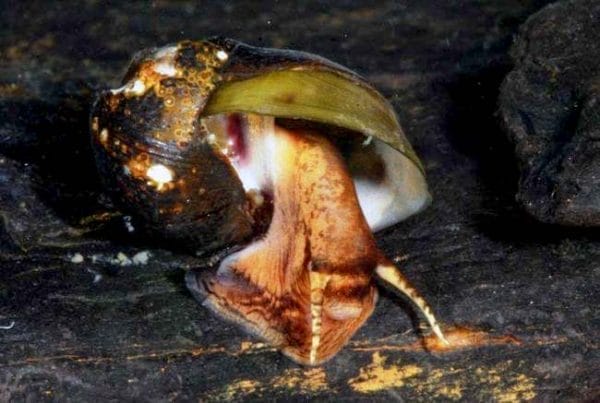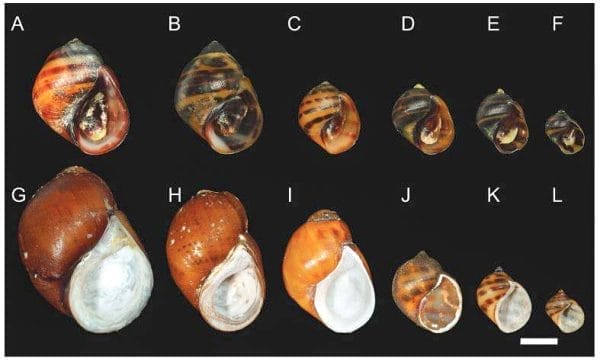Painted Rocksnail
 Painted Rocksnail
The painted rocksnail (Leptoxis coosaensis) is a freshwater snail historically found in Alabama rivers in the Coosa River system. Populations of painted rocksnails are now restricted to four locations in Calhoun, Chilton, Shelby, and Talladega Counties. This species was listed as threatened by the U.S. Fish and Wildlife Service in 1998 and has been given protected status by the Alabama Department of Conservation and Natural Resources.
Painted Rocksnail
The painted rocksnail (Leptoxis coosaensis) is a freshwater snail historically found in Alabama rivers in the Coosa River system. Populations of painted rocksnails are now restricted to four locations in Calhoun, Chilton, Shelby, and Talladega Counties. This species was listed as threatened by the U.S. Fish and Wildlife Service in 1998 and has been given protected status by the Alabama Department of Conservation and Natural Resources.
This snail species has undergone a complicated naming history. Leptoxis coosaensis was first described in 1861 by American geologist and conchologist Isaac Lea but for many years was thought to be the same species as Leptoxis taeniatus, first described by American geologist and mollusc expert Timothy A. Conrad in 1834. In 2017, scientists determined that Leptoxis taeniatus is the same species as the spotted rocksnail (Leptoxis picta), and the painted rocksnail was officially renamed Leptoxis coosaensis to better reflect its distribution. Scientists had believed that the habitat of the painted rocksnail stretched from the Alabama River to the Coosa River drainage basin. But the new research indicated that it has never occurred in the Alabama River. Many federal agencies still use the name Leptoxis taeniata when discussing the painted rocksnail.
Examination of shells collected in the last 150 years has led researchers to conclude that many painted rocksnails in museum collections were mislabeled as other freshwater snail species. For example, painted rocksnails are often misidentified as other threatened species such as the round rocksnail and the spotted rocksnail. Many of these species are visually identical and can only be identified by DNA sequencing and location. Whereas the painted rocksnail is found only in the Coosa River drainage, round rocksnails live only in the Cahaba River drainage. Spotted rocksnails are slightly larger and have less banding than painted rocksnails.
Painted rocksnails are approximately 0.8 inches in length (~2.0 centimeters) and have a round, spiral shell. On average, individual shells range from yellow to olive-brown with four prominent reddish-brown bands that wind along the shell. These bands are often broken into squares or oblongs. The snails have a soft orange-colored body with black patches and with a black band across the head, with another across the middle of their snout. Juvenile rocksnails look like miniature adults.
 Rocksnail Growth Patterns
Found around the shoals and riffles in strong river currents, painted rocksnails rarely travel far and spend their lives in the same area. Populations of painted rocksnail reside in Choccolocco Creek, Buxahatchee Creek extending into Watson Creek, Ohatchee Creek, and the Coosa River in the tailwater below Logan Martin Dam. They are often found attached to gravel, cobbles, bedrock ledges, and boulders. This habitat provides algae and bacteria for the snail to graze on. Painted rocksnails lay their eggs on rock ledges in clutches of three to five. The tan-colored eggs, approximately 0.012 inches in diameter (~0.3 millimeters), are deposited in a ring shape around one or two central eggs. Clutches of snail eggs can be found on rock ledges just below the waterline in the spring when the water temperature reaches 57 to 80 degrees Fahrenheit (~14 to 27 degrees Celsius). Painted rocksnails protect their eggs differently than other closely related species. Whereas other snails use algae and dead plant material as defenses, painted rocksnails use only mucus to protect their eggs from predation. Mucus also acts as a glue, solidly cementing the eggs to rocks until they hatch two weeks after being deposited.
Rocksnail Growth Patterns
Found around the shoals and riffles in strong river currents, painted rocksnails rarely travel far and spend their lives in the same area. Populations of painted rocksnail reside in Choccolocco Creek, Buxahatchee Creek extending into Watson Creek, Ohatchee Creek, and the Coosa River in the tailwater below Logan Martin Dam. They are often found attached to gravel, cobbles, bedrock ledges, and boulders. This habitat provides algae and bacteria for the snail to graze on. Painted rocksnails lay their eggs on rock ledges in clutches of three to five. The tan-colored eggs, approximately 0.012 inches in diameter (~0.3 millimeters), are deposited in a ring shape around one or two central eggs. Clutches of snail eggs can be found on rock ledges just below the waterline in the spring when the water temperature reaches 57 to 80 degrees Fahrenheit (~14 to 27 degrees Celsius). Painted rocksnails protect their eggs differently than other closely related species. Whereas other snails use algae and dead plant material as defenses, painted rocksnails use only mucus to protect their eggs from predation. Mucus also acts as a glue, solidly cementing the eggs to rocks until they hatch two weeks after being deposited.
Painted rocksnails play an important role in their ecosystem. They act as a “janitor,” cleaning the rocks of excess algae and removing dead plant matter for other bottom-dwelling species, including crayfish and insects. They also serve as an important food item for crayfish, turtles, fish, and ducks. In fact, several endangered species rely on freshwater snails as a food source. Threatened turtles and endangered fish such as the snail darter depend on a healthy river ecosystem to provide an abundance of snails for meals. Pollution from fertilizers, sediments, and herbicides degrade habitat and make it more difficult for snails to maintain healthy populations.
The greatest threat to all known populations of painted rocksnails is impoundment. Dams cause river currents to slow, which results in sediments accumulating on the hard rock preferred by painted rocksnails. Barriers prevent snails from moving to new locations to establish new populations. Slow waters also provide more opportunities for water chemistry changes, algae blooms, decreasing oxygen levels, and increased acidity. Freshwater snails are very sensitive to pollution and habitat alterations and populations will disappear if the water chemistry is disturbed. As the human demand for resources in the area increases, there will be a continued degradation of the aquatic ecosystem of the Coosa River system. As a result, it is highly unlikely that populations of painted rocksnail will survive without a high degree of protection and management. Under the Endangered Species Act, it is unlawful to take, kill, capture, sell, trade, or possess painted rocksnails. The primary recovery strategy for painted rocksnails is to carefully consider future modifications of the river and to encourage community maintenance and management responsibilities among all stakeholders in the Coosa River Basin. With community support behind ecosystem and watershed planning, conditions in the watershed can be improved to provide better habitat for the animals that depend on access to clean water.
Further Reading
- Hartfield P. D. Recovery Plan for Six Mobile River Basin Aquatic Snails. Atlanta, Ga.: U.S. Fish and Wildlife Service Southeast Region, 2005.
- Whelan, Nathan V., Paul D. Johnson, and Phillip M. Harris. “Life-History Traits and Shell Morphology in the Genus Leptoxis Rafinesque, 1819 (Gastropoda: Cerithioidea: Pleuroceridae).” Journal of Molluscan Studies 81 (2015): 85-95.
- Whelan, Nathan V., Paul D. Johnson, Jeffery T. Garner, and Ellen E. Strong. “On the Identity of Leptoxis taeniata—A Misapplied Name for the Threatened Painted Rocksnail (Cerithioidea, Pleuroceridae).” Zookeys 697 (2017): 21-36.



